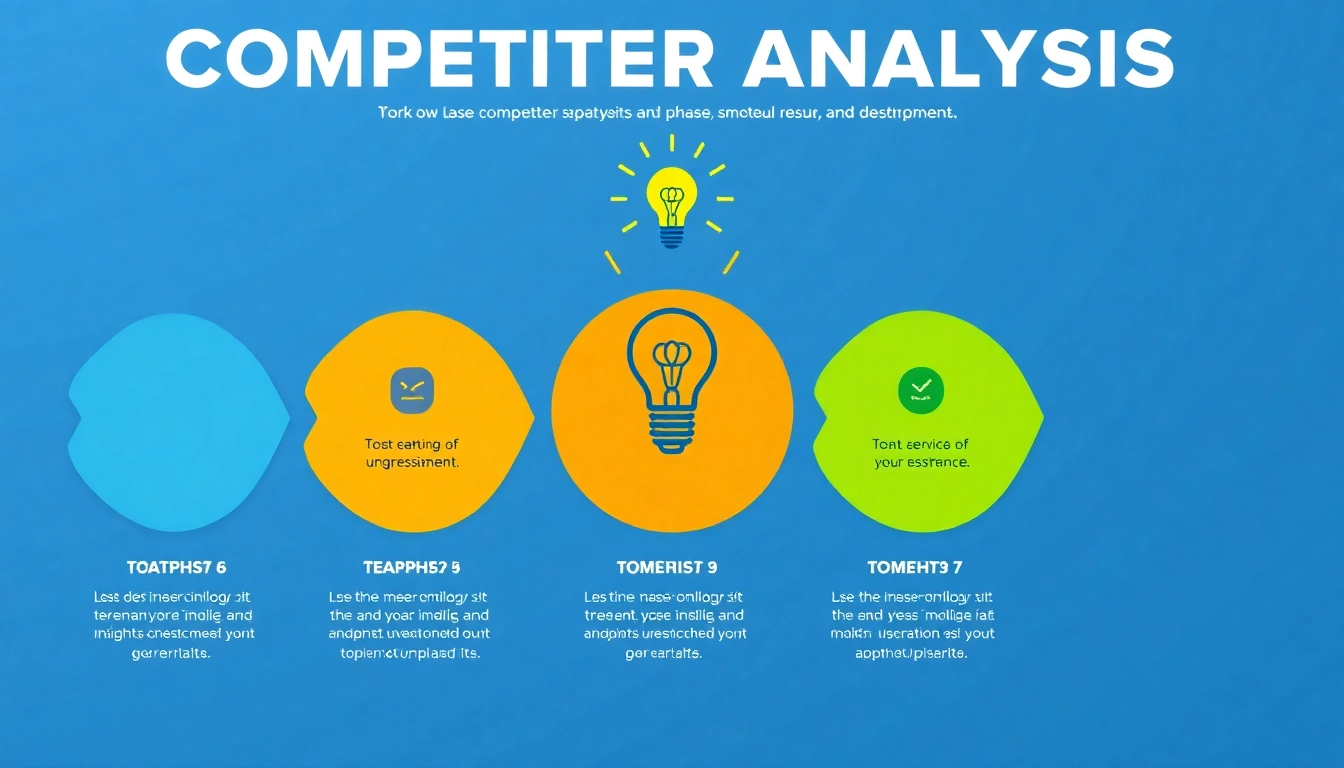Understanding Competitor Analysis
Definition and Importance
Competitor analysis, also known as competitive analysis or competition analysis, is the systematic approach to examining businesses within your industry that are similar to yours. It involves analyzing their offerings, branding strategies, sales tactics, and overall marketing approaches. Understanding your competitors is crucial, as it allows you to identify your strengths and weaknesses, tailor your marketing strategies, and position your business effectively in a crowded marketplace. A well-executed competitor analysis can uncover market trends, help anticipate your competitors’ moves, and provide actionable insights for your business strategy.
Types of Competitor Analysis
Competitor analysis can be categorized into several types based on the specific focus and the information being gathered. Here are some common methods:
- Direct Competitor Analysis: This focuses on businesses that offer the same products or services and are targeting the same customer base.
- Indirect Competitor Analysis: This involves assessing businesses that offer different products but still compete for the same customer expenditure.
- Quantitative Analysis: Utilizing numerical data to compare aspects like market share, pricing models, and sales figures.
- Qualitative Analysis: Assessing qualitative factors, such as brand perception, customer loyalty, and marketing strategies.
- SWOT Analysis: Identifying the strengths, weaknesses, opportunities, and threats associated with the competitors.
When to Conduct a Competitive Analysis
It’s essential to conduct competitor analyses at strategic points throughout your business lifecycle. Here are some key moments:
- Before Launch: Understanding the competitive landscape before launching a product or service can help define your unique offering.
- During Market Growth: As your market expands, conducting regular assessments can showcase emerging competitors and new trends.
- When Facing Challenges: If your business is struggling, an analysis can help identify why competitors are succeeding and what you might need to change.
- When Entering New Markets: Before entering new geographic or demographic markets, understanding local competitors will provide better positioning opportunities.
Step-by-Step Guide to Conducting a Competitor Analysis
Identifying Competitors
Identifying your competitors is the first step in any competitive analysis. Start by segmenting them into direct and indirect competitors. Direct competitors will typically be those businesses offering the same product line to a similar audience, while indirect competitors may satisfy the same customer need through alternative solutions.
Here are several steps to effectively identify your competitors:
- Keyword Research: Utilize keyword tools to see who ranks for keywords relevant to your industry.
- Online Searches: Perform Google searches for specific products and services to find companies that appear on the first few pages.
- Social Media Platforms: Investigate which brands are active in your space on platforms like Instagram, LinkedIn, and Facebook.
- Industry Reports: Consult industry research reports that detail existing players in your market.
Gathering Data on Competitors
Once your competitors are identified, the next step is gathering data. Information can be acquired from various sources, both online and offline:
- Company Websites: Review their websites to understand their offerings, pricing, and branding strategies.
- Customer Reviews: Analyze customer feedback on platforms like Yelp or Trustpilot to glean insights into competitors’ strengths and weaknesses.
- Marketplace Listings: If applicable, review listings on e-commerce platforms to understand pricing and promotional approaches.
- Annual Reports and Press Releases: If your competitors are publicly traded, their financial documents can provide performance metrics and strategic initiatives.
Analyzing Competitor Strengths and Weaknesses
After data collection, the next phase is analysis. A focused SWOT analysis can help identify key aspects of your competitors:
- Strengths: What do they do well? This might include high brand loyalty, extensive product offerings, or strong supply chain management.
- Weaknesses: Where do they fall short? This can include limited service areas, outdated technology, or poor customer service.
- Opportunities: Are there gaps in the market that they are not addressing? Analyze emerging trends that could give your business an edge.
- Threats: Consider economic, political, or technological changes that could affect their stability.
Tools and Resources for Effective Competitor Analysis
Top Competitor Analysis Tools
There are several tools available that can significantly aid in conducting a thorough competitor analysis. Here are some highly recommended ones:
- SEMrush: Excellent for SEO analysis and keyword research to see your competitors’ online strategies.
- Ahrefs: Highly effective for backlink analysis and content research to understand your competitors’ SEO tactics.
- SimilarWeb: Provides insights into website traffic and audience demographics, allowing comparisons across competitors.
- BuzzSumo: Great for analyzing content performance and identifying influencers who can sway your target audience.
- SpyFu: Effective for PPC competitor analysis to uncover their ad spend and keywords.
Leveraging Analytics Platforms
Analytics platforms can offer invaluable insights into competitor traffic, engagement levels, and audience behavior. Platforms like Google Analytics, Facebook Analytics, and others allow you to benchmark your performance against competitors effectively. Key metrics to watch include:
- Traffic Sources: Understanding where their website visitors originate can highlight successful marketing channels.
- Visitor Behavior: Analyze user engagement metrics to see how well they retain audience attention compared to your own.
Using Social Media Insights
Social media platforms provide rich data about competitors. Investigating their social media presence can reveal their engagement tactics and audience sentiments.
Key strategies include:
- Analyzing Content Types: Observe the types of posts that yield the most engagement, such as videos, images, or texts.
- Follower Engagement: Monitor how frequently they respond to customer inquiries and engage with their audience.
- Influencer Collaborations: Identify any influencer marketing strategies they may be employing to boost brand awareness.
Best Practices for Competitor Analysis
Keeping Analysis Up to Date
The business environment is ever-changing, which necessitates that your competitor analysis be a living document. Regular updates can ensure your insights remain relevant:
- Scheduled Reviews: Set regular intervals for reviewing and updating your competitor analysis—preferably quarterly or bi-annually.
- Monitor News and Trends: Stay aware of industry changes that could affect competitor strategies.
- Subscribe to Newsletters: Many media groups offer insights related to competitive landscapes, market shifts, and emerging players.
Actionable Improvements
A successful competitor analysis should lead to actionable insights. After collating and assessing your findings, consider these steps:
- Refine Your Unique Selling Proposition (USP): Use insights to adjust your USP or highlight aspects that set you apart from competitors.
- Marketing Strategy Optimization: Base changes in your marketing approach on successful tactics showcased by competitors, double-checking with your target audience’s preferences.
- Focus on Product Development: Identify what your competitors lack and use that to inspire innovation or improvement in your own offerings.
Creating a Competitive Edge
Ultimately, the goal of any competitor analysis is to build a sustainable competitive advantage. Here are effective strategies:
- Cultivate Customer Relationships: Strong customer service and engagement can differentiate you in saturated markets.
- Innovation and Adaptability: Encourage a culture of innovation within your firm to stay ahead of industry trends.
- Brand Storytelling: Develop a compelling brand narrative that resonates with your target audience and sets you apart.
Case Studies: Successful Competitor Analysis
Industry Examples of Effective Analysis
Understanding how top companies leverage competitor analysis can illuminate best practices. Consider these case studies:
Case Study: Airbnb
Airbnb continuously monitors competitors such as traditional hotels and other short-term rental platforms. By identifying gaps in services offered by competitors, they innovated their user experience, promoting unique stays rather than just offering a place to sleep. Airbnb’s strong competitive analysis allowed them to capitalize on newer markets, setting themselves apart from conventional lodging options.
Case Study: Coca-Cola vs. Pepsi
The ongoing rivalry between Coca-Cola and Pepsi demonstrates how both companies utilize competitor analysis for marketing campaigns. Analyzing each other’s advertising strategies, pricing, and product placements enables them to adapt their responses strategically. For example, when Pepsi launched the ‘Pepsi Challenge,’ Coca-Cola’s subsequent rebranding and marketing strategies were directly influenced by competitive insights.
Key Takeaways from Leading Brands
From the above examples, we can gather several key takeaways:
- Focus on Customer-Centric Strategies: Successful brands prioritize customer preferences and pivot their strategies according to insights from competitor behavior.
- Leverage Data Analytics: Leading brands utilize robust analytics tools to inform their competitive strategy effectively.
Lessons Learned and Future Trends
As markets evolve, so too must our approaches to competitor analysis. Here are some future trends to consider:
- Increased Use of AI: Predictive analytics driven by AI can further enhance competitor analysis, making insights more accurate.
- Emphasis on Sustainability: As customers become increasingly conscious about sustainability, competitors’ positions on environmental issues will be critical to analyze.
- Technology Integration: Integrating advanced technological solutions into product and marketing strategies based on competitors’ innovations may provide a necessary edge.




